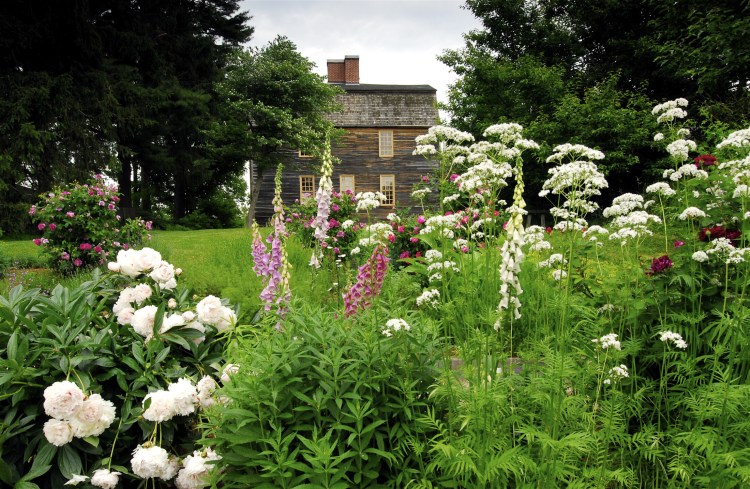Two-hundred years ago when Maine became a state, few homes here had ornamental gardens. It was an agrarian society, and farm families in Maine, and elsewhere, were more concerned with subsistence than beauty, growing vegetables they could eat, with maybe a few herbs and flowers.
The few wealthy homeowners who did plant trees, shrubs and perennials to beautify their property took their cues from Europe. Andrew Jackson Downing, the man considered the founder of landscape architecture in America, wasn’t born until 1815, so no distinct American style existed in 1820.
Although naturalistic gardens were being created in Europe by then, in North America the rectilinear style popular in the previous two centuries persisted, “perhaps because it met man’s psychological need to feel he could master a world that was still largely untamed,” speculates Encyclopedia Britannica.
Certainly, those who did plant ornamental gardens had ever-expanding choices. Plant explorers of the era were bringing new plants to market all the time. Famed English botanist Joseph Banks, for instance, brought 3,500 species to Kew Gardens in London over his lifetime; he died the year Maine became a state. In “Stewards of the Land,” Robert R. Harvey writes that 7,000 species of plants were available commercially in 1800, a number that grew to 13,000 by 1825 and 27,000 by 1850. It was a time of great change in ornamental gardening.
Several gardens now open to the public were already in existence when Maine became a state; in fact, they predated the event by a decade or more. These gardens, and in many cases the homes, too, are much changed, though. The families who lived in them 200 years ago weren’t thinking that their homes and gardens were – or rather, would become – historic. They simply planted what they liked.
The two gardens open to the public that come closest to the 1820 statehood date are both in Wiscasset: The Nickels-Sortwell House at 121 Main St. (Route 1), and Castle Tucker at 2 Lee St. Both are owned by Historic New England. When I stopped by five years ago, the gardens at the Nickels-Sortwell House were under renovation. It’s a small lot, and I haven’t had the chance to return, so I can’t tell you how they look today. Castle Tucker has excellent views, but the landscape is not the reason to visit.
The Sarah Orne Jewett House in South Berwick, however, is known for its gardens. The house was built in 1774 and owned by Jewett’s grandparents. Jewett was born there in 1849. Historic New England, which owns this property, as well, has a map of the its gardens in 1835, just 15 years after Maine got statehood.
Jewett wrote about the gardens, including its herbs, and described them in “The Country of the Pointed Firs,” her most famous work. The property is also featured in her novel “Deephaven.” Her story “Martha’s Lady” reveals the pleasure she took in gardens:
“The front door might be shut, but the garden door at the other end of the broad hall was wide open upon the large sunshiny garden, where the last of the red and white peonies and the golden lilies and the first of the tall blue larkspurs lent their colors in generous fashion.”
Once you’re in South Berwick, you may want to visit other nearby old homes with gardens – the Hamilton House in South Berwick, built in 1785, and the Sayward-Wheeler House, built in York in 1735; both are owned by Historic New England.

The gardens outside the Wadsworth-Longfellow House once extended as far as Back Cove. The gardens shrank as the city expanded. Photo courtesy of Maine Historical Society
The Longfellow House in Portland was built in 1785. Poet Henry Wadsworth Longfellow was born there in 1807; he grew up in the house and occasionally wrote about its garden. (“Gorgeous flowerets in the sunlight shining,/ Blossoms flaunting in the eye of day,/ Tremulous leaves, with soft and silver lining,/ Buds that open only to decay” ). But the garden is much changed from 1820. Once, it ran from Congress Street all the way to Back Cove. Today, it is just a few hundred feet long, hemmed in by the library of the Maine Historical Society, and beyond that, the city itself.
The poet’s sister, Anne Longfellow Pierce, created the plan for the current garden, which was part of the property she bequeathed to the Maine Historical Society in 1901. In the 1920s, the Longfellow Garden Club was formed to tend the garden, and is still is charged with taking care of the site. Only a single plant, a lilac, survives from the 1901 garden. When I worked in downtown Portland, I occasionally would eat lunch there.
Nearby is the First Parish Church in Portland, which housed the meeting where the vote was taken to seek statehood. The church also has a nice garden, but it is not historic by any means.
The Tate House, off outer Congress Street in Portland, was built in 1755 and is now a museum. The gardens there have been recreated from Tate family records and an archaeological dig done in 2014. Because the Tate family owned a farm elsewhere, they grew mostly herbs in the garden by the house, according to Tate House docents. The original garden featured no foundation plantings and no lawn, but it did have a few rose bushes.
The Mallett House, at 40 Ossipee Trail in Standish, dates from 1789. While much of the house has been preserved as it was, the gardens have evolved over time. They do look good, though.
And with any of these properties, at the least, visitors can get glimpse of how life in Maine used to be.
Tom Atwell is a freelance writer gardening in Cape Elizabeth. He can be contacted at: tomatwell@me.com.
Send questions/comments to the editors.



Comments are no longer available on this story